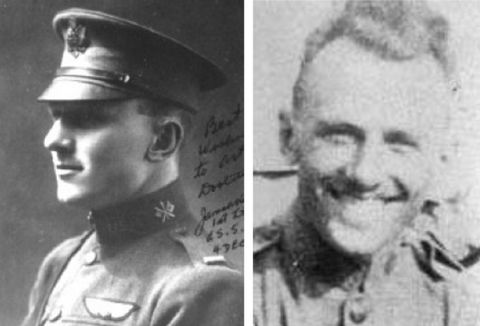Personnel Index - Detail
Awarded the DFC & DSC.......see below for details.
Flew with Observer Lt E A Simpson.

During the actions described below Lt Keating was flying a DH9, serial C2202.
The DFC:
For gallantry and skill. On 9 August 1918, he bombed Falvy Bridge from 1,000 feet obtaining a direct hit. The formation was attacked on its way home by 25-30 EA and a running fight ensued to our lines. Lt. Keating showed exceptional coolness and judgement, and by skilful flying, enabled his observer to shoot down two EA in flames over Marchélepot and Ablaincourt. Two more EA were shot down by the formation and seen to crash in the vicinity of Soyecourt. His machine was so badly shot about that he was forced to land in the shell crater area. On 8 August 1918, after bombing Bethencourt Bridge from 800 feet, obtaining a direct hit, he found seven Pfalz scouts attacking his formation from the rear. He maneuvered for position, enabling his observer to shoot down one in flames over Bethencourt. On 17 July 1918 he bombed Passy Bridge from 500 feet, destroying it just as a column of transport was passing. He then opened machine gun fire on the troops in the vicinity, causing many casualties and great disorder. He has taken part in many successful bomb raids and his excellent example of coolness and courage in action is of the greatest service to his squadron.
From the Supplement to the London Gazette
The DSC:
The Distinguished Service Cross is presented to James Alfred Keating, First Lieutenant (Air Service), U.S. Army, for extraordinary heroism in action in the skies over France during the months of July and August, 1918. On August 9, 1918, Lieutenant Keating bombed Falvy Bridge over 1,000 feet, obtaining a direct hit. On returning, his formation was attacked by enemy planes and a running fight ensued. By skillfully flying with exceptional coolness he enabled his observer to shoot two planes down in flames. On August 8, 1918, after bombing Bethincourt Bridge over 800 feet, obtaining a direct hit, he found 7 enemy planes attacking his formation from the rear. By maneuvering for position he enabled his observer to shoot one down in flames over Bethincourt. On July 17, 1918, he bombed Passy Bridge over 500 feet, destroying it just as a column of transport was passing. He then opened machine-gun fire on the troops in the vicinity, causing many casualties and great disorder. His exceptional courage and splendid bravery were a constant inspiration to the members of his command.
From General Orders No. 9, W.D., 1923
